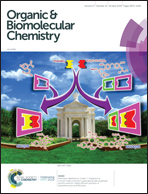Transition state analysis of an enantioselective Michael addition by a bifunctional thiourea organocatalyst†
Abstract
The mechanism of the enantioselective Michael addition of diethyl malonate to trans-β-nitrostyrene catalyzed by a tertiary amine thiourea organocatalyst is explored using experimental 13C kinetic isotope effects and density functional theory calculations. Large primary 13C KIEs on the bond-forming carbon atoms of both reactants suggest that carbon–carbon bond formation is the rate-determining step in the catalytic cycle. This work resolves conflicting mechanistic pictures that have emerged from prior experimental and computational studies.

- This article is part of the themed collections: Catalysis & biocatalysis in OBC and New Talent


 Please wait while we load your content...
Please wait while we load your content...